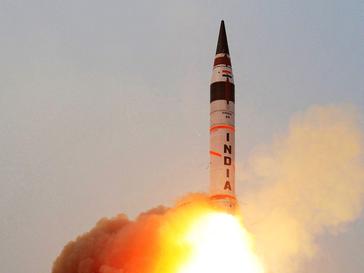India’s Agni 5 ICBM: The Asian Missile Race Heats Up

Featured image: Image of Agni-V missile launch. (Source: Page 9 of this PIB file)
India’s successful test launch of the Agni 5 ICBM reignited the Asian missile race by disrupting the strategic balance with China & Pakistan and sparking a more pronounced security dilemma than before. Up until last week, it was doubtful that India could ever target China’s eastern seaboard cities in the event of a military confrontation, thus limiting any potential clash between the two to whichever border region or perhaps even maritime space that it breaks out in, but that state of affairs was just smashed after New Delhi proved that it could potentially strike deep into the People’s Republic if the order was given.
On the one hand, this promotes the concept of “mutually assured destruction” by somewhat equalizing the missile capabilities of these two Asian Great Powers and theoretically making war between them less likely, but on the other hand, that very same logic could be abused by India in a bid to keep China at bay if it ever engages in another conventional war with Pakistan. The surge of confidence that the successful Agni 5 launch has imbued India’s decision makers is causing fear throughout the region, especially since New Delhi made a highly publicized show of standing up to Beijing last summer over the Donglang/Doklam Plateau.

Suddenly confronted with a new strategic challenge, China might opt to invest in and ultimately deploy a missile defense shield to protect against this threat, as could Pakistan, both of which would in any case be following in India’s own footsteps to set up this technology. The problem, however, is that the US might interpret their moves as being a cover for fielding systems that could secretly have the dual purpose of restricting the American Air Force’s freedom of movement in the East & South China Seas and via the Pakistani corridor to Afghanistan and Central Asia.
The situation is exceptionally dangerous because all four countries involved are nuclear powers, but there are also other tangential consequences relating to the peripheral players of Iran, North Korea, and Japan. It’s natural to expect the US to help Japan improve its missile capabilities in response to any advances made by China in countering India, while Iran and North Korea’s relevant programs are already developing independently of the others’ but inadvertently provide a pretext for the US to position its global missile defense infrastructure near their borders.
Altogether, the basis for the Asian missile race was established long ago, but nowadays this competition is slated to heat up with unpredictably destabilizing results following the Agni 5’s successful test launch.
*
Andrew Korybko is an American Moscow-based political analyst specializing in the relationship between the US strategy in Afro-Eurasia, China’s One Belt One Road global vision of New Silk Road connectivity, and Hybrid Warfare.

